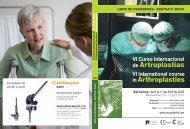cadera / hip - Active Congress.......
cadera / hip - Active Congress.......
cadera / hip - Active Congress.......
You also want an ePaper? Increase the reach of your titles
YUMPU automatically turns print PDFs into web optimized ePapers that Google loves.
JUEVES / THURSDAY<br />
244<br />
movement of the contact point between the<br />
femur and the tibia with increasing fl exion.)<br />
Proponents of the four-bar link model point to<br />
studies that have shown a decreasing radius<br />
of curvature of the femoral condyles from<br />
distal to posterior.<br />
Several recent studies of knee joint kinematics<br />
have suggested that the knee can be<br />
modeled as having a single axis of fl exionextension.<br />
Similarly, the internal and external<br />
rotation of the tibia around the femur (i.e.,<br />
the pivot) of the knee can be modeled by an<br />
axis roughly at the central part of the medial<br />
condyle. (van Dijk et al. 1983, Blankevoort et<br />
al. 1988, Hollister et al. 1993, Mancinelli et al.<br />
1994, Blaha et al. 2003) These studies show<br />
that the normal knee does not roll-back, but<br />
rather remains remarkably constant in position<br />
on the medial side (like a ball in a socket)<br />
while varying in contact position on the lateral<br />
side to accommodate internal and external<br />
rotation of the tibia about the femur.<br />
Kinematic studies of total knee prostheses<br />
designed respecting the concept of the “fourbar<br />
link” and providing for roll back have demonstrated<br />
paradoxical kinematics. Instead of<br />
rolling back, these knees demonstrate sliding<br />
forward of the femur on the tibia during in<br />
vivo fl uoroscopic studies. A similar kinematic<br />
study done with a knee joint designed for medial<br />
pivot and medial ball-in-socket kinematics<br />
does not demonstrate paradoxical motion.<br />
(Banks et al. 1997, Dennis et al 1997, Blaha<br />
et al. 1998)<br />
The Advance“ Medial-Pivot (Wright Medical<br />
Technology, Arlington TN USA) total knee<br />
prosthesis has been in clinical use for 5<br />
years (as of January, 2003). Based on the<br />
preliminary results available at the time of<br />
the writing of this abstract the medial ball-insocket<br />
confi guration of the implant appears<br />
to provide a clinical result characterized by<br />
enhanced anterior-posterior stability both to<br />
clinical examination and in functional use.<br />
ROTATION IS THE FINAL<br />
SOLUTION: MOBILE<br />
BEARING TOTAL KNEE<br />
R. “Dickey” Jones, M.D.<br />
U.T. Southwestern Medical Center,<br />
Dallas, TX, USA<br />
Surface wear in TKA remains a problem<br />
producing sub-micron wear particles which<br />
accumulate in periprosthetic tissue leading to<br />
cytokinin release and osteolysis. A physiological<br />
knee joint simulator was used to compare<br />
fi xed bearing to a rotating platform design of<br />
the same knee system. Despite similar contact<br />
areas the rotating platform bearings had<br />
4 times less wear under high kinematics than<br />
the fi xed bearings. Polyethylene orientates<br />
in the principle direction of sliding and strain<br />
hardening with strength increase occurs parallel<br />
to sliding, but is reduced transverse to<br />
sliding. In fi xed bearings the increased multidirectional<br />
motion of the femoral component<br />
relative to the bearing produces the multi-axial<br />
wear path, transverse friction forces and gives<br />
higher wear. With the Rotating Platform,<br />
rotation occurs at the tibial tray, diminishing<br />
multi-directional motion at the femoral<br />
interface, converting to uni-directional wear<br />
paths, decreasing transverse friction forces<br />
and producing signifi cantly lower wear. With<br />
higher kinematic inputs fi xed bearing TKAs<br />
show a fi ve fold increase in surface wear over<br />
lower inputs. The Rotating Platform produced<br />
94% less wear than the fi xed bearing over 6<br />
million cycles.<br />
Dynamic kinematic fluoroscopic studies<br />
confi rm the Rotating Platform moves with<br />
the femoral component and axial rotation<br />
occurs on the inferior aspect. The Rotating<br />
Platform accommodates to the patient’s gait<br />
kinematics, enhancing positive bone and soft<br />
tissue remodeling.





